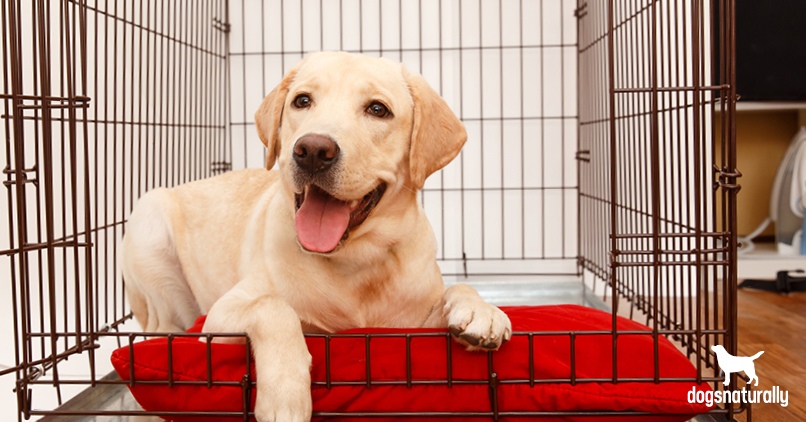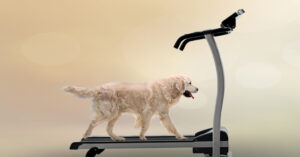Wondering how to crate train a puppy or dog? In theory, it should be easy. Their love of small, dark spaces should make any dog love having a crate to call their own. Essentially, puppies come pre-programmed with a love of crates.
But puppies also come with a pre-programmed need to be around their mother and littermates. The hardest part about crate training puppies is helping them understand that the crate doesn’t mean they will be separated from their family.
Forgetting that puppies need their family is the biggest mistake you can make. So let’s look at the best way to train a puppy by showing her the crate is a safe and happy place.
How To Crate Train A Puppy
Ready to pick up your puppy from the breeder or bring your dog home from the shelter? Make sure you have her crate ready before you bring her home.
The crate you buy can be either a wire crate or a hard plastic kennel. I like the plastic kennels because they’re more enclosed and your dog will appreciate that. But I use wire crates because they’re cooler than the plastic ones and easier to clean. Plus you can buy wire crates with dividers in them to keep your puppy in one end. This will make sure she doesn’t treat half of her crate as a bedroom and the other half as a bathroom.
The downside of wire crates is your puppy won’t feel as cozy in the big space. But if you put a blanket over three ends, this will meet her need for a dark little den.
What To Put In The Puppy Crate
Once you’ve purchased your puppy’s crate, here’s what you’ll need to furnish it. Again, make sure you have all this ready before the puppy comes home:
Toys And Treats: Every kid wants toys and snacks in their bedroom … and your newest kid is no different. Put your puppy’s best toys at the far end of his crate. Think about toys that won’t be a choking hazard, such as hard rubber toys. Make sure they’re large enough and can’t be swallowed!
You’ll also want plenty of delicious snacks in the puppy’s crate before she comes home. That will show her that her den is a seriously cool place to be.
Water: You can pick up a small, hamster water dispenser if you’re picky about a potential pool party. Otherwise, a small bowl of water or a small hanging pail will do. Large bowls invite larger messes (especially for water-loving breeds). And large hanging pails can be dangerous. Make sure the water bowl matches her size.
Make sure the puppy has fresh water any time she’s in the crate for more than an hour.
Bedding: You want your puppy’s new home to be cozy, so don’t skimp on the comfy decor. Buy a nice, soft bed for her crate. Ideally, you’ll want to buy two or three, so you can have one in the wash and one in the crate.
Not all puppies love soft surfaces. If it’s hot or if your puppy is a hot dog in general, she might push your nice bedding to the side. Don’t take offense … it’s her space and she can decorate any way that makes her feel comfortable.
Where To Put The Crate
For the first few days, have the puppy’s crate wherever you are when you’re home. This will encourage her to hang out in her den without feeling lonely or isolated.
The best place is a central room like your kitchen or family room. But it’s best to keep her in the same room as you for the first bit.
OK, you have your crate, and you have your new puppy or dog Here’s how to start off on the right paw …
Step 1: Introduce Your Puppy To The Crate
If you’re crate training a puppy, your job is simple: make every interaction puppy has with her crate a positive one. The best way to crate train a puppy is to go slow and try not to stress the puppy or yourself over the process. And the best way to reduce stress is for your puppy to associate the crate with good things for puppy.
Throughout the day, drop some yummy treats in your puppy’s crate. Finding edible treasures in her new room will build a positive association. You should also feed all your puppy’s meals in her crate for the same reason. If she’s hesitant to enter the crate, put her food dish and treats inside the doorway. Gradually move them to the back of the crate.
You can also take your puppy’s favorite toy or chew and tie it to the back of the crate. This will encourage her to lie down in the crate to play with it.
Step 2: Make Puppy Crate Training A Game
Once your puppy has gone in the crate a couple of times, it’s time to make a game of it. Let her see you with yummy treats or fun toys and toss them into the crate. Praise the puppy when she runs into the crate to retrieve them.
When your puppy comes back to you, start the game again. Do this five times in a row, several times a day.
After a few days of tossing treats in the puppy’s crate, you can start teaching her to go into the crate herself. Before you start this step, your puppy should already run into the crate to retrieve treats when you toss them in. When she does, toss the cookie in the crate. Ss she’s running inside, say “Get in your bed” and praise her when she does.
Repeat this about 5 times, for 10 sessions, until she races into the crate to get her treat. Then, you’ll want to make it a bit more challenging.
Next, instead of throwing the cookie in first, say “Get in your bed.” And wait until your puppy goes in the crate before you give her the treat. If she doesn’t, wait … and if she still doesn’t go in, end the session.
Try another session in a bit and go back to throwing the cookie in first, then you can try the cue again. When she goes into her crate on cue, give her several cookies and make a huge deal out of her. Do it a couple more times, then end the session.
The key to your crate training success with a puppy is to always leave her wanting more.
Step 3: Close The Door
Once your puppy goes into the crate on cue, it’s time to close the door. Ask her to “Get in your bed” again, then close the door once she goes in. You still want to give her treats … but this time, feed them through the door. Give her three or four treats, then open the door. Repeat this about 5 times.
Next, walk around the crate after you close the door. Toss treats at your puppy as you do, then let her out after a minute or two. Make this a fun game. Once you can do a few laps around the crate, it’s time for the next step.
Step 4: Short Stays
The next step to crate training a puppy is to build up some duration. Get your puppy a special bone to chew on, place her crate beside your chair and put some toys in the crate. Then cue up Netflix. Your goal is to have your puppy crated beside you for an hour or two.
Make a point of getting up and going to the kitchen for a drink or a snack. But make sure you’re back in a minute or so. You can even bring snacks back for the puppy. Her first experience in lockdown needs to be a very, very positive one!
If she starts to cry or throw a tantrum, ignore it. Never open the door if she is vocalizing … you will train her to throw tantrums to get out of the crate. Never reward behaviors you don’t like.
After about half an hour, let the puppy out of the crate, as long as she’s quiet. Open the door and say “OK.” Don’t fuss over your puppy. You want the fun and treats to happen while she’s in the crate and behaving nicely, not outside the crate.
Once she exits the crate, give her the cue to go back in again and give her something delicious when she goes inside. This time, don’t close the door.
If the puppy doesn’t go back in the crate, try to bribe her with toys or treats. Do whatever you can to get her back in the crate, but don’t lock her in it. You want her to learn that going in the crate doesn’t mean she has to be there for a long time.
Your puppy can then relax outside the crate while you finish your movie.
Step 5: Longer Stays
If movie night was a success, it’s time for longer duration lockdowns. For the next few days, lock the puppy in her crate when you’re home for longer periods. Do your housework, get caught up on your taxes, do some work or laundry … all while she is relaxing in her crate.
She may vocalize excited behavior, but remember to never open the crate when she does. Rewarding any behavior will make it happen more often.
Be sure to keep checking in and giving treats. You want your puppy to learn it’s no big deal if you disappear … and that you’ll always come back. So when you start to leave the room, praise the puppy when come back and give her a treat.
To set your puppy up for success, always make sure she has a nice chew when you put her in her crate.
Continue to come and go and praise her when you’re out of her sight. Make a big deal out of how good she is and drop by her crate often to drop treats in for her.
If your puppy will go in her crate willingly and stay without crying, you can extend your puppy’s crate time without you around. Here’s a good schedule for extending lockdowns:
- 1 minute
- 5 minutes
- 15 minutes
- 30 minutes
- 1 hour
- 2 hours
- 3 hours
- 4+ hours
Be sure to throw in some shorter duration stays as you increase the time. Continue asking your puppy to go in her crate for just a few seconds to a minute with lots of rewards.
Step 6: Leave The House
When she is happily relaxed in her crate, you can start to leave the house. Use the same schedule above and continue to mix in short stays with lots of cookies.
Once you ask her to hang out alone in her crate for an hour or more, make sure you set her up for success. The best time to ask her to stay home alone is when she’s tired. Take her out for a good romp before you leave for an hour or longer. And make sure you give her water and a good chew toy.
It’s important that you leave and return without any fanfare or fuss. You’ll want to spend lots of time snuggling your puppy, but now is not the time. Be businesslike with departures and arrivals.
If you make a big deal out of leaving, she’ll learn to make a big deal of leaving!!
Crate Training A Puppy At Night
Despite your best efforts, the first night may be a bit stressful for your puppy. There may be crying, there may be barking or puppy may pee in the crate at night. Don’t worry, the crate training process will get better!
The key to success is to place the dog’s crate crate right beside your bed for the first few nights or weeks. Remember, you don’t want your dog to associate her crate with you leaving! She should be close enough that you can stick your fingers in the crate. If she vocalizes at night, tell her she’s a good puppy and put your fingers in through the crate door. She’ll appreciate the company and should settle back in and go right to sleep.
How Long Does It Take To Crate Train A Puppy?
The amount of time it takes to get puppies used to a dog crate varies. It depends on how well you can associate the crate with good things for puppy. If you don’t skip steps and start with short lockdowns with you in the same room, it should only take a few days.
If you skip steps and lock your puppy in the crate too soon or too long, you’ll know it. You’ll be dealing with a puppy crying in her crate and not settling. She’ll be stressed, and you’ll have to work harder to convince her that the crate is a happy, safe place to be.
Puppy Crate Training Troubleshooting
With a little work and planning, your puppy will quickly and happily adapt to her crate. There may be some bumps in the road, so here are some extra tips to keep you on track.
Puppy Crying In Crate
It’s perfectly normal for your puppy to cry or whine in the crate for the first few days. After that, extended periods of crying mean you went too fast or skipped steps. If your puppy is crying in her crate for more than a few minutes, go back to steps 1 through 4.
Puppy Crying In Crate At Night
If your puppy is crying or whining in her crate at night, the simplest solution is to have the crate beside your bed. Often, just reaching into the crate and letting puppy know you’re there is enough for her to feel secure and fall back asleep. If your puppy doesn’t settle, then it could be that she needs to be taken out to potty.
Puppy Peeing In Crate
Always be sure your puppy has eliminated before you put her in her crate. If your puppy pees in her crate while you’re out, never punish her. Wash the crate out with a safe enzymatic cleaner. Don’t use products with ammonia … they’re not good for your puppy. They also smell like urine, so your puppy may think it’s OK to soil the crate if it smells like a potty.
Expect her to soil in her crate for the first few days or weeks … and don’t be surprised if she aims for the bedding! If this is the case, you have a few options:
- Use a smaller crate.
- Use a divider in the crate.
- Remove the bedding (although it works, this one seems a bit less kind)
DNM RECOMMENDS: When accidents happen, make puppy bath times safe with 4Legger All-Natural Certified Organic Dog Shampoo. Buy 4Legger now >>
How Long Can A Puppy Stay In A Crate?
Remember, young puppies can’t hold on as long as older dogs can. Here’s a guideline of how long your puppy should be in her crate without potty breaks:
- 8-10 weeks 30-60 minutes
- 11-14 weeks. 1-3 hours
- 15-16 weeks. 3-4 hours
- 17+ weeks 4–6 hours*
*Unless crated overnight, puppies and adult dogs should never be in their crate for more than 5 or 6 hours at a time.
Avoid The Crate As Punishment
You’ve gone to a lot of work to make your puppy love her crate and call it home. So you’ll want to keep up the games and practice for the first couple of months.
If she gets too rambunctious or misbehaves, it might be tempting to use her crate as punishment. You can use the crate for time-outs. But only once your puppy starts to love her crate and can tolerate it for more than an hour.
Forcing your puppy into her crate or yelling at her to get in it will make the crate a scary place. Besides, it’s always best to tell puppy what you want her to do instead of punishing her for the wrong behaviors.
The Benefits Of Crate Training A Puppy
Crate training a puppy or dog is important. Crates may seem cruel to us, but crates can actually meet your dog’s need for safe, den-like enclosures. There are other good reasons to crate train your dog or puppy.
Crates Make House Training A Snap : Dogs, by instinct, don’t like to soil where they sleep, so they will let you know when they need a potty break.
RELATED: How to potty train a puppy in 2 easy steps …
Crates Can Reduce The Risk Of Separation Anxiety: Dogs naturally feel safe and cozy in small little places. So a crate provides a perfect safe place to calm your dog.
Crates Prevent Destructive Behaviors: While your puppy or rescue dog is learning your house rules, she might shred your couch or chew on your chairs. A crate will prevent her from wreaking your stuff or hurting herself when you’re not around to supervise.
Crates Make Dogs Safer For Children: If you have children, you can teach them that dogs in crates are off limits. No touching dogs in crates! This way, your dog can escape to her den when she’s not in the mood to hang with the kids. Tired or stressed dogs can bite.
Crates Are Mobile Hotel Rooms: If you’re traveling with your dog, she’ll appreciate her cozy bedroom to feel at home wherever she is.
Crates Make Vet Visits Less Stressful: If your dog has to spend time at the vet, a crate will help her relax and heal.
So crates aren’t only important for puppies and new-to-you dogs. A crate is for life. Even if you remove the door, most dogs will love to curl up inside their crates for a sleep.
Crate Training Puppies Is A Snap
Poorly crate trained dogs hate their crate because it becomes a cue that they’re going to be alone for a while. Dogs are pack animals and being alone is not only unnatural for your dog … it’s stressful! So crate training is essentially training your dog to tolerate being alone.
Crate training a puppy the right way will help your puppy feel safe and secure while her family is out for the day. So go slow and have patience.
FAQ
Is it OK to let a puppy cry in a crate at night?: It’s normal for puppies to cry in their crate at night initially, but it’s important to ensure they’re comfortable, have had a chance to eliminate, and are not in distress, gradually teaching them that their crate is a safe space.
How long can an 8-week-old puppy stay in a crate?: An 8-week-old puppy should not be crated for more than 2 hours at a time during the day, as they need frequent potty breaks and social interaction.
How long will it take to crate train a puppy?: Crate training a puppy typically takes from a few days to a few weeks, depending on the puppy or dog’s age, temperament, and past experiences.
How do I get my puppy to stop whining in his crate?: To stop a puppy from whining in his crate, ensure he’s well-exercised, has gone to the bathroom, and has comforting items like toys or a blanket; ignore the whining unless it’s time for a scheduled potty break.













